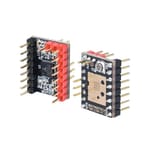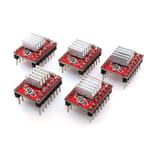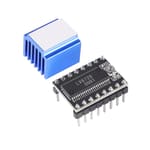Stepper motors are the specific type of high-torque motor commonly used in 3D printers to control the moving parts. Stepper motors work with a magnetically sensitive shaft that moves when the electromagnetic coils surrounding it are powered. When only one coil is powered fully, this is called a full step because the shaft moves one entire step.
However, the shaft can also move by microsteps, achieved by powering two electromagnetic coils at different levels. Microstepping is a more precise way of movement with its own benefits and downsides. There are different levels of microstepping depending on the fraction of a full step the motor moves (e.g. 1/32, 1/64).
Stepper motor drivers are the component on a 3D printer’s mainboard responsible for controlling the power given to the electromagnetic coils on a stepper motor to rotate the motor’s shaft a specific distance. The drivers and their microstepping abilities have a significant effect on the noise produced by the printer.
If you used stepper motors only equipped for full steps to achieve a half step, the electromagnetic coils would constantly be receiving and losing power, and the shaft would oscillate between the two coils in an approximation of the halfway point. This oscillation would cause a lot of vibration, making a lot of noise. The better a stepper motor driver’s microstepping abilities, the fewer vibrations it will make and the quieter the printer will be.
There are many different brands and models of stepper motor drivers, and they all vary in quality and effectiveness. In this article, we’ll go over a few options that are great for 3D printers. We’ll also provide some guidance on what you should consider when looking to replace your printer’s stepper motor drivers, as well as an overview of the most popular stepper motor driver features.
TMC2130
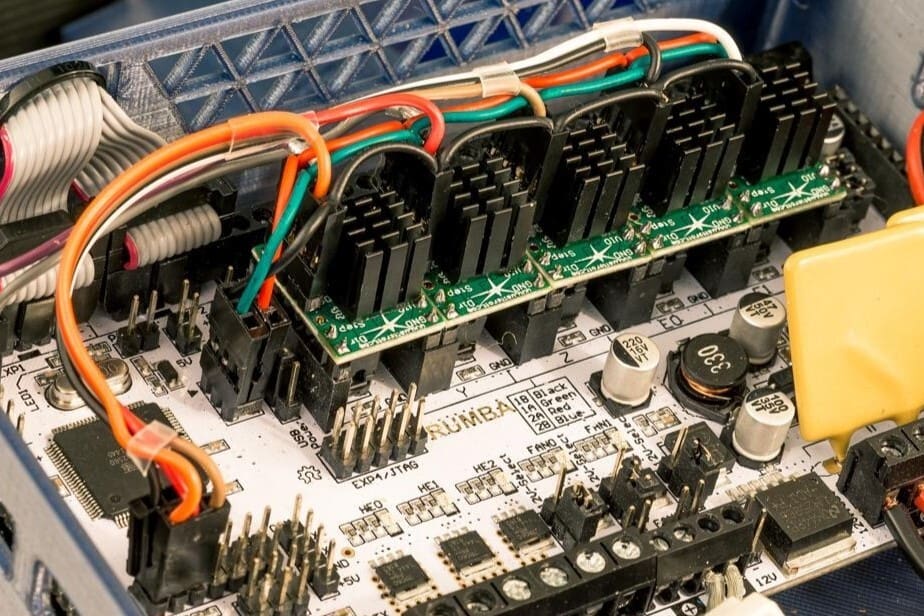
The TMC2130 driver is the older brother of the TMC2100, most commonly found under the hood of Prusa Research’s printers and Prusa clones. While most drivers are made for various motion control uses, Trinamic Motion Control designed the TMC2130 specifically for 3D printers.
This driver is on the more expensive side of stepper motor drivers, but what it lacks in affordability, it makes up for in quality. TMC2130 drivers can make your 3D printer super silent; makers mention that they could only hear fan noises.
The TMC2130 model driver is capable of 1/256 microstepping and can operate in either StealthChop or SpreadCycle mode. It’s also equipped with different TMC technologies, including StallGuard2, CoolStep, short protection, and ChopSync. These features can improve your machine’s prints by upping your driver’s performance and making them more reliable and smarter, like measuring stepper motor load.
We recommend the TMC2130 over the TMC2100 because the TMC2130 supports CoolStep and StealthChop, both useful features. The price difference between the two is also quite low.
In short, the TMC2130 is a great option for building a new 3D printer, as it’s been designed with 3D printing in mind. We recommend purchasing SPI-configured TMC2130 modules, as the standalone mode doesn’t allow using StealthChop or CoolStep.
- Developer: Trinamic Motion Control
- Microstepping rating: 1/256
- Driver modes: StealthChop, SpreadCycle, with other features like ChopSync, StallGuard2, MicroPlyer, and CoolStep
- Price: ~$10
TMC2209
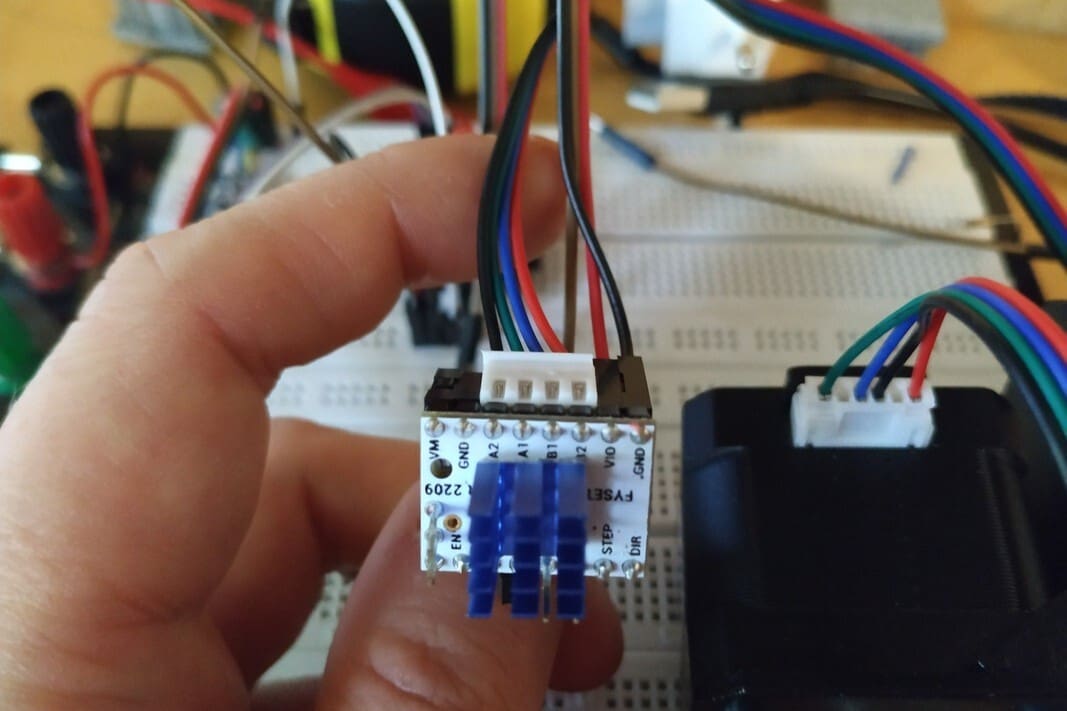
With some new features over their predecessor, the TMC2209 drivers are Trinamic Motion Control’s improved version of the TMC2208 drivers. We used to recommend the TMC2208s, but they lack sensorless homing and compatibility with Marlin’s linear advance feature. The TMC2209 supports both.
StallGuard4 is also supported. It improves the driver’s StealthChop2 capability and enables the driver to support CoolStep. This will allow the driver to run cooler with less power than the TMC2208s. The TMC2209s also support a higher maximum current of 2.0A from 1.5A.
If you’re debating between the TMC2208 and TMC2209, the support for linear advance alone can be worth the slight price difference. Just make sure the TMC2209s are cooled properly; the YouTuber Michael Laws of TeachingTech points out that they can get fairly hot.
Like most modern stepper motor drivers, TMC2209s are known to make your 3D printer very quiet, and you can find them on a few mainboards, like the BigTreeTech SKR E3 V1.1. They also work with the UART communication mode.
We highly recommend the TMC2209 as the go-to choice when upgrading a 3D printer’s drivers or even when custom-building your own printer. The advanced features will undoubtedly improve your printing experience and are worth the price.
- Developer: Trinamic Motion Control
- Microstepping rating: 1/256
- Driver modes: StealthChop2, SpreadCycle, CoolStep, StallGuard4, and MicroPlyer
- Price: ~$5
TMC2225
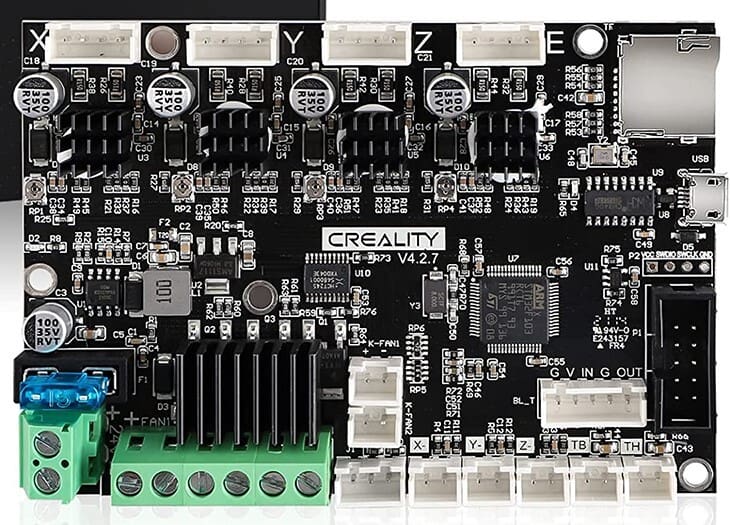
The TMC2225 is a stripped-down version of the TMC2209, bringing its cost down. These affordable drivers can be found on Creality’s V4.2.7 silent board.
The TMC2225s punch well above their price, thanks to its features. It has 1/256 microstepping and StealthChop2, allowing for very quiet and precise printing. It also supports UART.
Make sure to cool this driver effectively or it could lose steps, especially at high levels of microstepping. Also beware that this driver operates in standalone mode, meaning that using linear advance with Marlin firmware isn’t possible.
If all you want is to lower noise and increase precision – all at a low price, try the TMC2225s.
- Developer: Trinamic Motion Control
- Microstepping rating: 1/256
- Driver modes: StealthChop2, SpreadCycle, MicroPlyer
- Price: ~$4
TMC5160
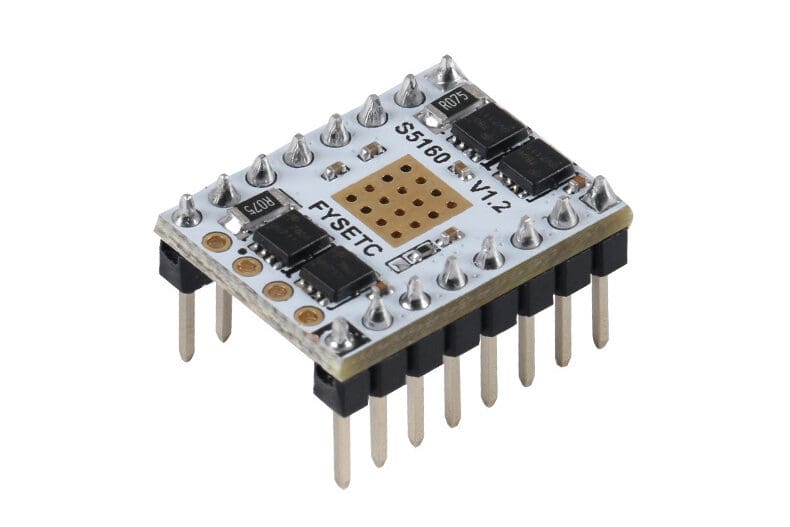
The TMC5160s are a beefier and even more feature-packed version of the TMC2209s. Most stepper drivers range from 0-2A, while the TMC5160s go from 0-10A! It can also run on up to 60 volts.
This huge increase in amperage and voltage means you can drive larger motors, such as NEMA23 motors, commonly found on CNC machines. Also, high-speed printers, such as the Voron and its derivatives, utilize larger motors, as they can handle the forces required to quickly move axes much better than NEMA17 motors.
TMC5160 drivers run cooler than the TMC2209s, which increases the lifespan of your driver and reduces the risk of thermal cycling damaging it over time. They also have SixPoint for improved acceleration control. Lastly, the drivers work in SPI and UART mode, making configuration a breeze.
If you’re looking to build a high-speed 3D printer or run huge machines, the TMC5160s are your best bet. They’re pricey, but overall, they’re the best choice for these workloads.
- Developer: Trinamic Motion Control
- Microstepping rating: 1/256
- Driver modes: StealthChop2, SpreadCycle, StallGuard2, CoolStep, DcStep, SixPoint motion, MicroPlyer
- Price: ~$15
A4988
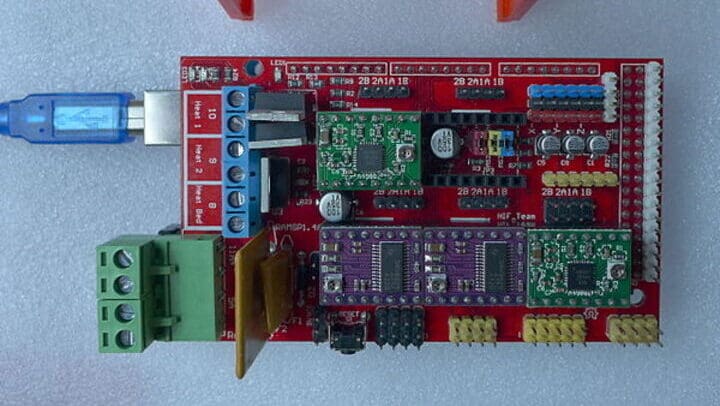
The A4988 driver, designed by Allegro MicroSystems, is relatively old compared to the other drivers on this list. While the A4988 isn’t the latest or greatest driver model, it’s a reliable option for 3D printers. They can be found integrated into lower-end mainboards like Creality’s earliest Ender 3 boards, namely the V1.1.2 and V1.1.3.
Depending on the manufacturer, these drivers are usually rated down to 1/16 microstepping, which certainly doesn’t stand out from the crowd but may meet your minimum requirements. Also, they won’t make your motors as quiet as the newer drivers (e.g. TMC2209).
Unlike most drivers nowadays, the A4988 drivers don’t have many compatible modes, meaning they won’t be able to perform some 3D printing features. Also, in some reviews, users have noted that adjusting the driver’s potentiometers (voltage divider tool) can be difficult. Still, they’re a tried-and-tested option that certainly won’t break the bank!
- Developer: Allegro MicroSystems
- Microstepping rating: 1/16
- Driver modes: Mixed current decay, slow current decay, with an automatic selection feature
- Price: ~$2
LV8729
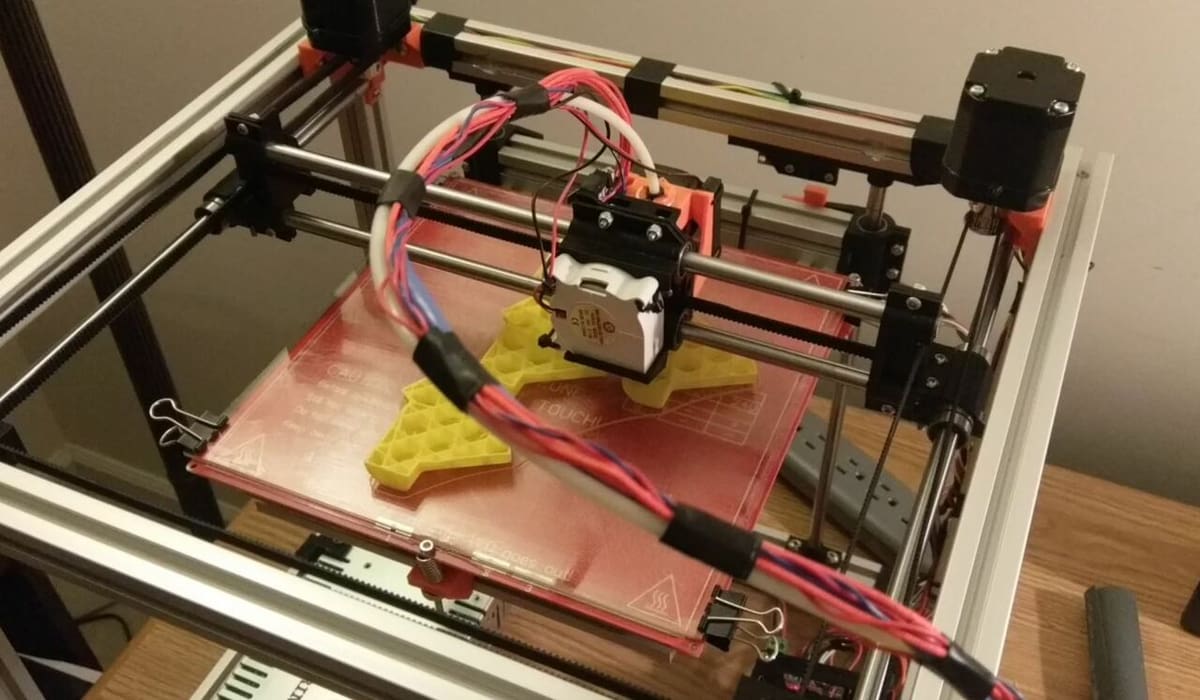
Lastly, the LV8729 driver is a less popular driver option but is still a great choice due to its low price. This driver isn’t integrated into any popular mainboards, but it’s available to purchase as an attachment for open-ended RAMPS boards (popular model of 3D printer mainboard).
This model has a few improved features over the A4988 driver but is still below the calibre (and price) of some others on our list. Based on the audio from TeachingTech’s test, this driver is louder than most modern drivers but slightly quieter than the A4988 driver. Still, some users have claimed that the driver can handle fast speeds (like 170-mm/s fast) pretty well.
The LV8729 driver is capable of 1/128 microstepping, making the driver great for achieving more dimensional accuracy at a low cost. The LV8729 driver model also requires minimal wiring to achieve this value of microstepping, but the driver doesn’t have many other features or optional modes.
- Developer: OnSemi
- Microstepping rating: 1/128
- Driver modes: StealthChop
- Price: ~$4
Considerations
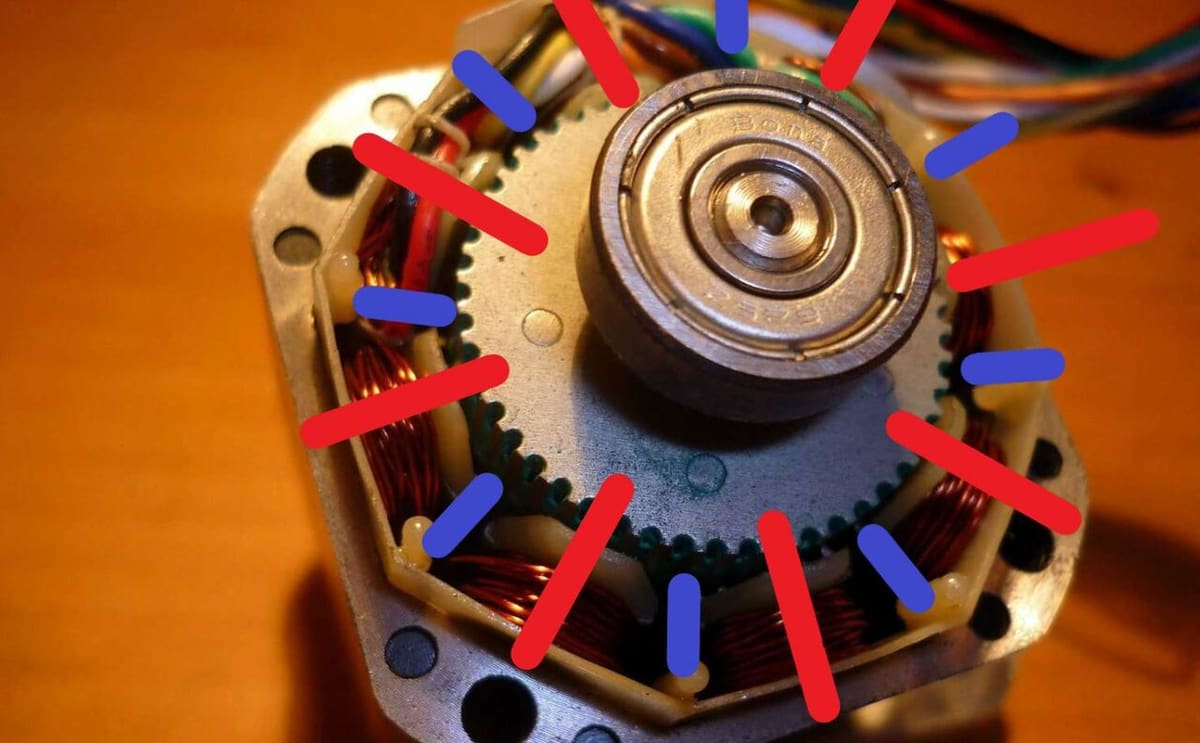
In putting together this list, we took into account the stepper motor driver manufacturers, looking for reputable brands with experience in the electronics field. However, brands aren’t everything.
Microstepping Ratings
Microstepping ratings – the smallest fraction the stepper motor driver can handle – are important for quality. A smaller microstepping rating (indicated by a large denominator in the microstepping fraction) means higher levels of detail but can often make the drivers more expensive.
Modes
Another important consideration is what driver modes exist and what firmware they’re compatible with on your stepper driver. Stepper drivers can run in three modes: Step/Direction, SPI, and UART.
- Step/Direction is the most barebones method of running your stepper drivers. It doesn’t allow for any useful features and often limits how many microsteps you can achieve.
- SPI allows us to use intelligent features, such as MicroPlyer or automatic mode-switchin. This removes the need for certain sensors and promotes better driver management.
- UART is the most common intelligent mode, allowing you to change the mode you use on the fly.
SPI and UART let you change other settings directly from your firmware, but UART lets you do even more. We recommend using stepper drivers with UART mode where possible.
If you need a refresher on the most popular stepper motor driver features, check out the glossary of driver mode terms below.
Firmware
There are three main firmware types: Marlin, Klipper, and RepRapFirmware (RRF). In the world of 3D printing, nearly every driver out there works with every type of firmware. However, it’s important to note that enabling certain firmware features can require a stepper driver to have access to certain modes of operation or features to work. Some firmware features or versions may be incompatible with certain drivers, so make sure to thoroughly check your firmware’s documentation for compatibility with drivers you purchase.
Price
There’s no point in buying the most expensive drivers on this list when you don’t need to use them. To make it easier to choose, we’ve included information about appropriate use cases for each driver. For example, you probably don’t want to use an A4988 to drive a Voron – an A4988 would catch fire trying to run the motors at the required current for the speeds used on a Voron.
Glossary of Driver Modes Terms
Let’s go over common features in stepper drivers sold today. These terms are important to understand so you can make the best choice.
MicroPlyer
MicroPlyer is an interpolator for microstepping. It transforms step resolutions into microsteps by interpolating the time between step pulses. This is what allows for high rates of microstepping, such as 1/256.
StealthChop / SpreadCycle
StealthChop and SpreadCycle are the two most common modes of running TMC drivers on. StealthChop, as the name suggests, is a quieter mode of operation and reduces the loudness of the low-frequency hum. However, it’s recommended to avoid StealthChop for print speeds above 100 mm/s, as the risk of layer shifts increases greatly. SpreadCycle is a fast driver mode and reduces resonance effects, which can produce artifacts such as salmon skin.
ChopSync
ChopSync is the ultimate in speed. It goes one step further than SpreadCycle and allows for motor velocities of several thousand RPMs. Although you’ll almost certainly never need this kind of speed, it’s a fun feature to have if you’re into extreme high-speed 3D printing.
StallGuard
StallGuard is a sensorless feature that allows the driver to detect significant resistance during movement. It’s required for sensorless homing, where the driver will force an axis to move until it encounters high resistance, with that point becoming a machine limit.
CoolStep
CoolStep, as the name suggests, allows the driver to monitor its temperature and run cooler than similar drivers by using less energy. It’s a special application of StallGuard that uses StallGuard’s ability to deliver high-resolution load detection to precisely modulate the current delivered to the motor and improve efficiency, which can reduce temperature.
Precise current modulation also allows the driver to boost the motor’s current for situations where there’s more resistance than normal but not enough to trigger the StallGuard threshold. Drivers that use CoolStep also utilize SpreadCycle.
DcStep
DcStep is a less-common but unique technology. It bridges the gap between closed-loop steppers and open-loop. In an open-loop system, the motor and driver are unaware of any changes made to the motor’s real position. This means that skipped steps can lead to layer shifts, ruining a print.
Closed-loop systems are aware of positional changes not made by the driver and correct for them. TeachingTech has a great video on open vs closed-loop steppers. DcStep modifies motor torque and speed on-the-fly to push past resistance while preserving the step count.
SixPoint
SixPoint is a unique feature not found in most stepper drivers. Out of this list, it’s only available on the TMC5160. SixPoint modifies acceleration, ramping up and down using the motor’s torque curves. It uses two different acceleration settings to do so, giving it fine control over acceleration, improving print quality.
License: The text of "The Best Stepper Motor Drivers for 3D Printers" by All3DP is licensed under a Creative Commons Attribution 4.0 International License.
CERTAIN CONTENT THAT APPEARS ON THIS SITE COMES FROM AMAZON. THIS CONTENT IS PROVIDED ‘AS IS’ AND IS SUBJECT TO CHANGE OR REMOVAL AT ANY TIME.


